Do Potato Towers Work? (Read BEFORE You Try!)
Do potato towers work? Comparing results of DIY wire cage, straw mound, wood box vs bag methods, & best ways to grow potatoes with big yields!
We have all seen those potato towers with incredible promises like “grow 100 pounds of potatoes in 4 square feet!” But have you seen an ACTUAL example of a productive potato tower? No.
We tried it. It failed to produce more potatoes than we planted. Every video, book, and blog articles we looked through ( a LOT ) all started with great enthusiasm and ended with no updates on harvest, or completely disappointing results admitted by a few brave souls.
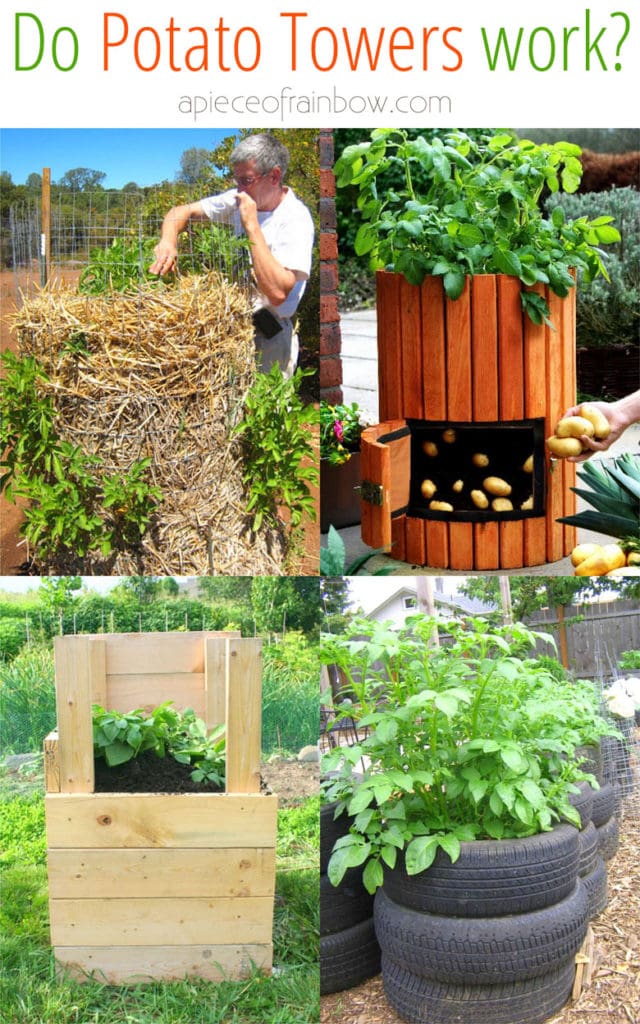
We typically don’t devote a whole article on something that doesn’t work. But this potato tower myth is so popular that we just don’t want more fellow gardeners to waste an entire season and much work for such poor results.
So today we are going to show you why potato towers don’t work, and what to do instead. There are some much better options! 🙂
*Some resources in article are affiliate links. Full disclosure here.
Popular kinds potato towers and how they are supposed to work
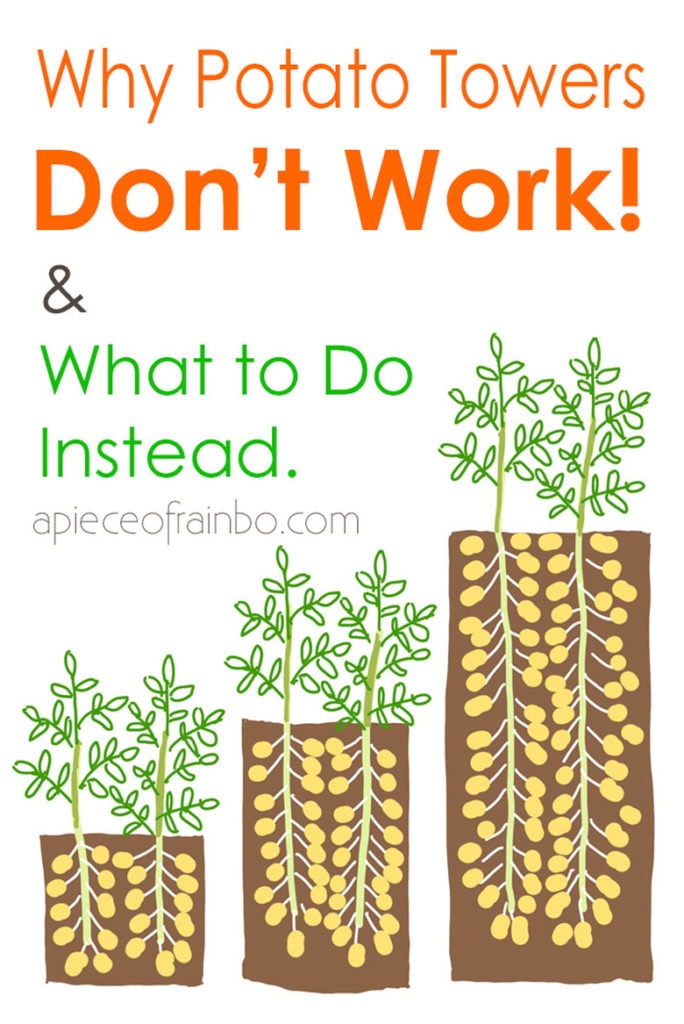
Most potato towers are made from chicken wire, wood, stacked buckets, or even rubber tires. They are usually over 3 feet tall.
The idea behind most Potatoes towers is that if you keep mounting dirt or straw or mulch on potato plant stems as they grow, more potatoes will grow from the stems. The higher you mount around the stems, the more potatoes you will get.
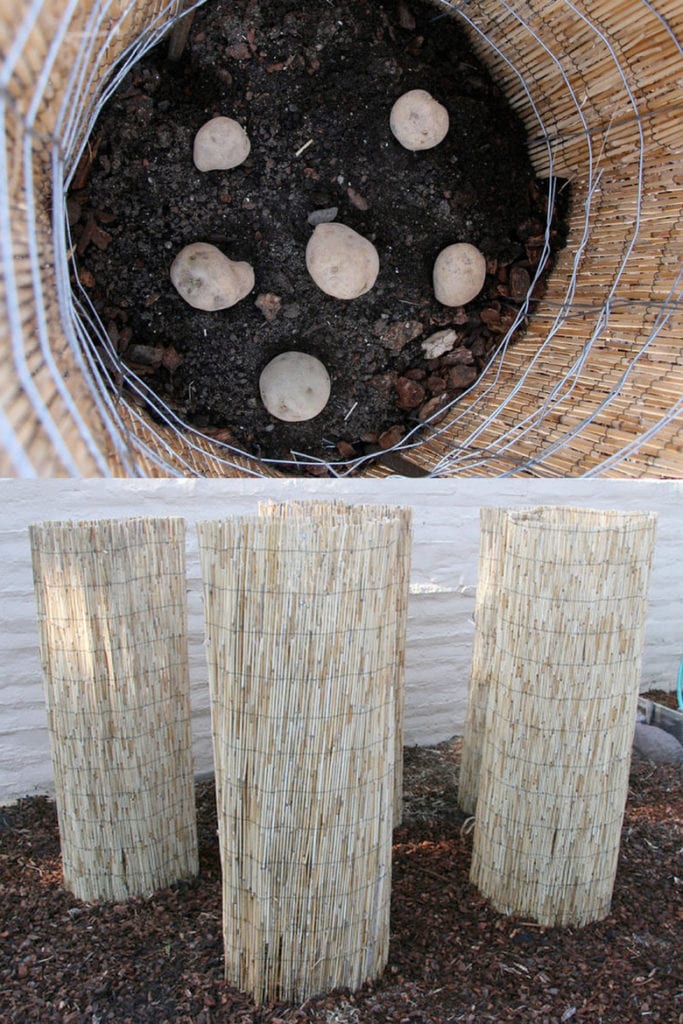
Another way people use potato towers is based on vertical gardening. They would put a few seed potatoes on each layer of soil as they add soil every few inches. So a potato tower that is 4 foot high can hold about 50 seed potatoes. The potato towers here are from Sunset, beautiful, yet no update on the harvest results. Images by Sunset.
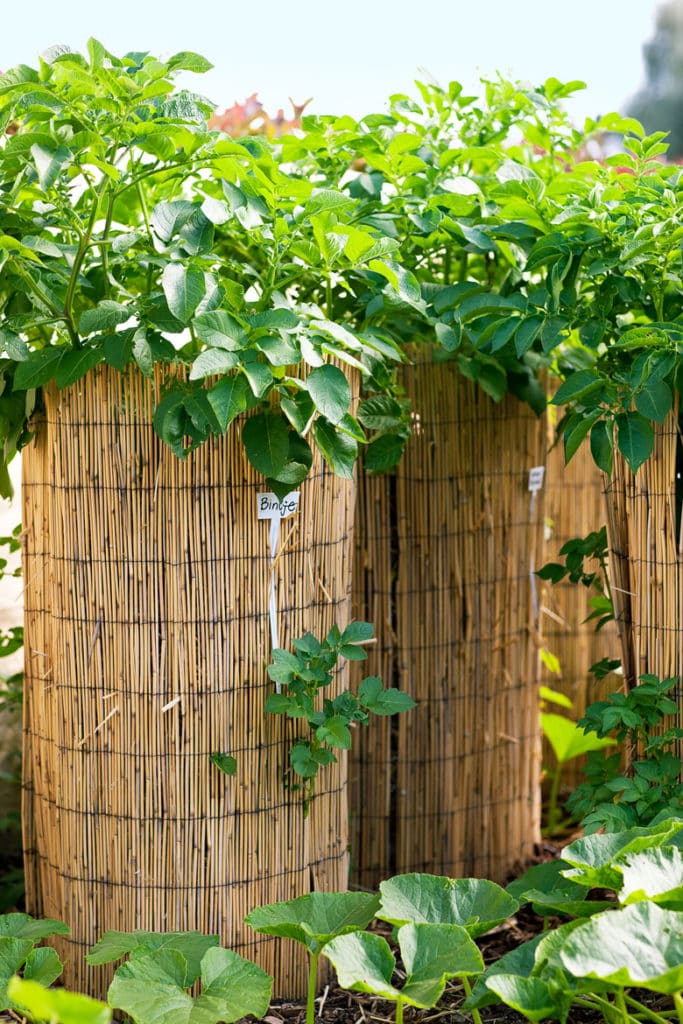
The potatoes would grow out of the top and sides of the tower, making you excited about “growing 100 lbs of potatoes in 4 square feet”. We all love small space gardening ideas, except that, this one doesn’t work!
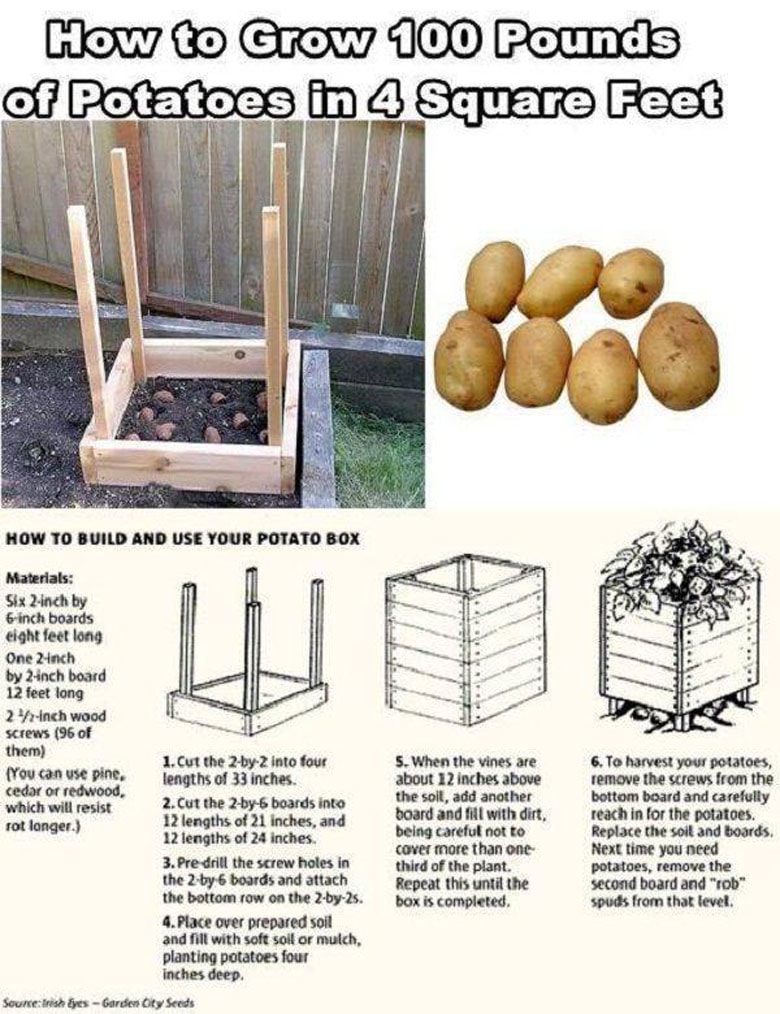
Another example of the “grow 100 pounds of potatoes in 4 square feet!” idea. The design is no longer found on the original site.
Why potato towers don’t work
Like tomatoes, potatoes also come in determinant and indeterminate varieties. Determinant potatoes (such as Yukon Gold) only form new potatoes in a single layer right above the seed potatoes.
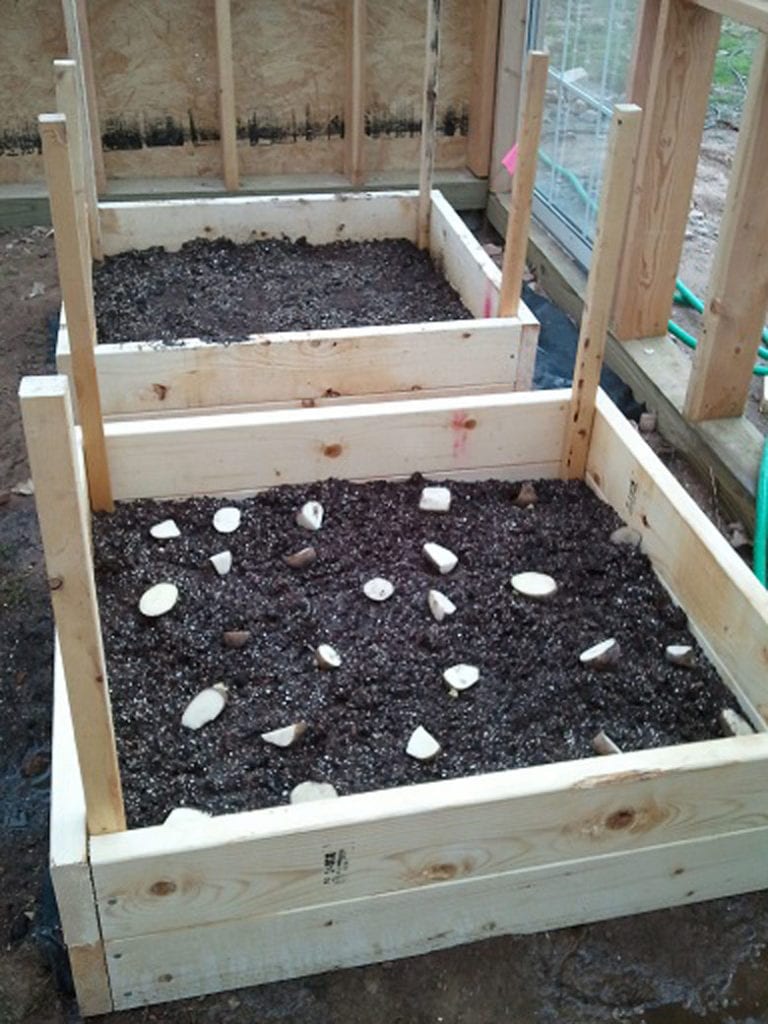
Indeterminate potatoes and most fingerling potatoes keep forming new tubers but no more than about 12” above the seed potatoes. So in a potato planter like above, you will not increase production by mounding dirt or straw to more than 12” high.
The main purpose of hilling, aka mounding soil or mulch up the base of potato plants, is to protect the newly formed potatoes from being exposed to sun light, turning green, and becoming inedible.
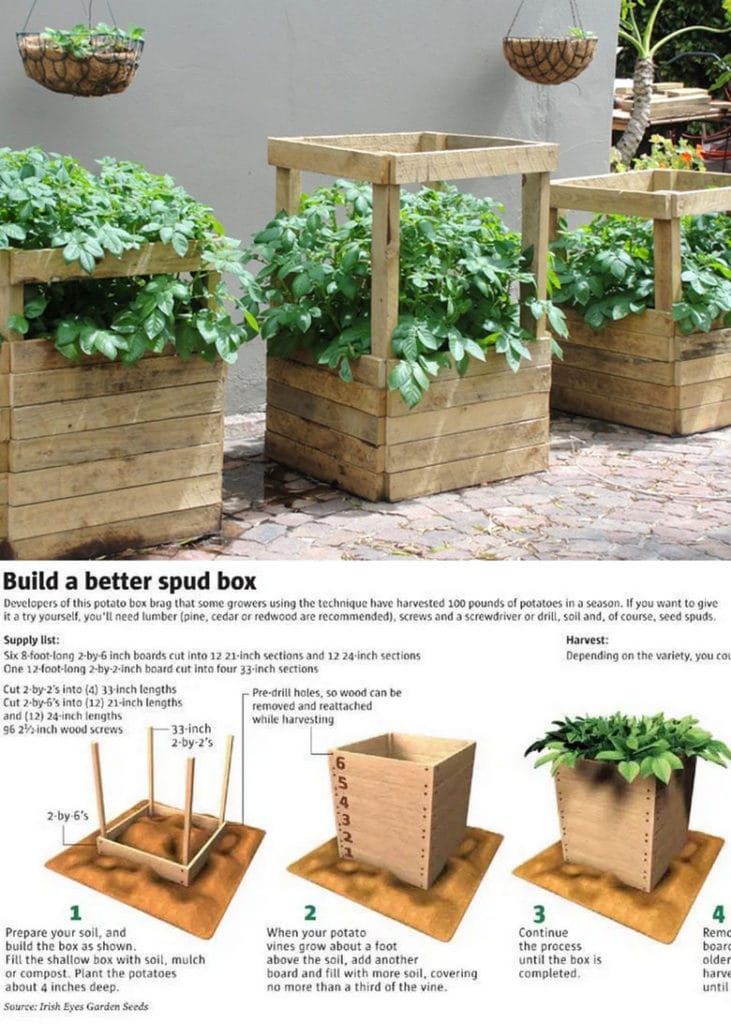
Wendy’s family built these potato boxes and tested the idea to keep adding slats to the frame as the potato plants grow. Their conclusion: a disappointing result of 20 potatoes from 3 big towers!
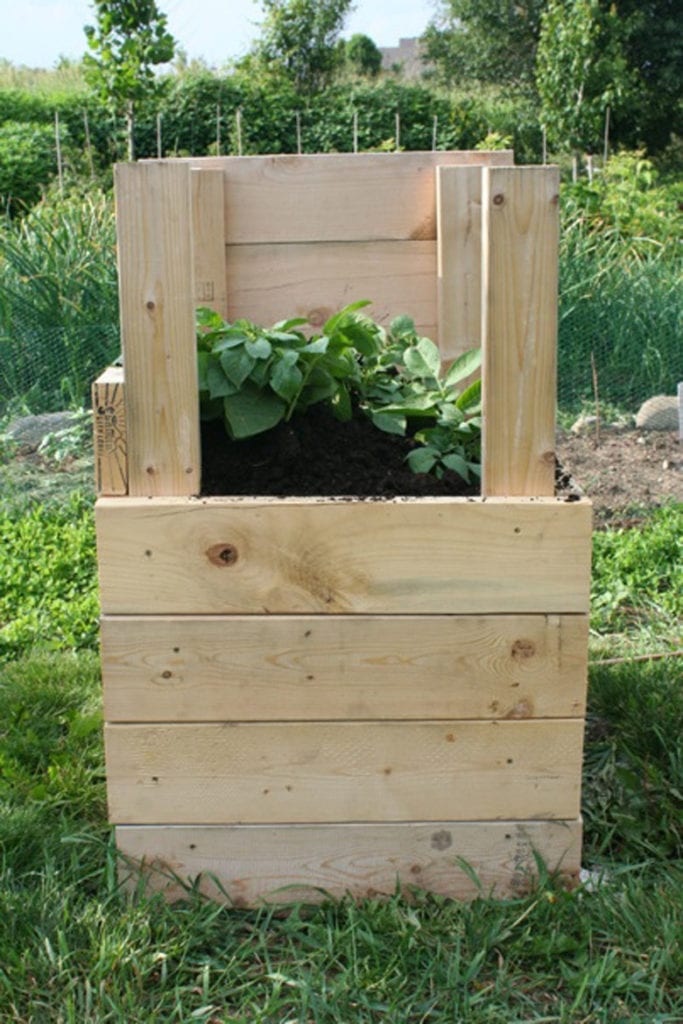
Rob at One Straw had a similar experience: the harvest was no where near 100 lbs per potato tower. It was about 3 lbs for the 1 lb planted.
In fact, when the straw, mulch or soil mound is too high, it will decrease production! The green foliage on potato plants need to be massive, lush and healthy because they feed the roots.
If we keep burying the stems and only leaving a tiny bit of leaves at top, the roots will not receive enough energy to form new potatoes!

Another popular version of potato towers is to use wire cage filled with straw, soil, and mulch. Becca at Wild Gourd Farm called their big wire cage and straw potato tower “3 feet of disappointment!”
What about the second idea where you plant layers of seed potatoes in one tower and let the plants grow on all sides as in vertical gardening?
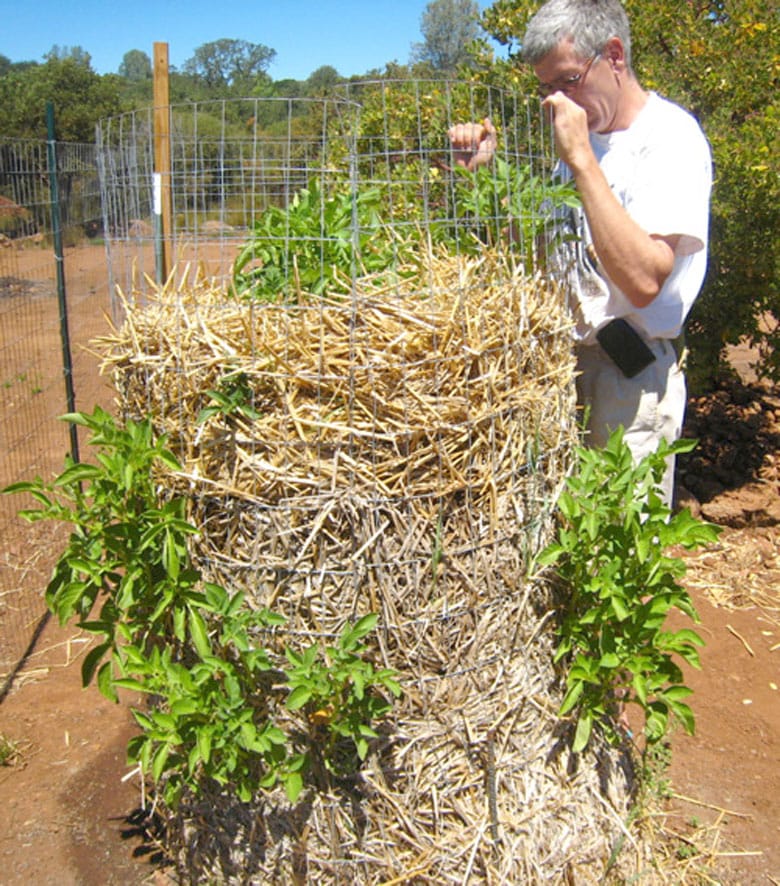
Roy at Plan Garden tested this idea, and got 10 lbs of potatoes from 3 lbs of seed potatoes, well below the 10:1 ratio of potato yields.
Here are a couple of reasons why these potato towers don’t work very well. They are usually made of chicken wire of other porous materials. As an intensive vertical potato planter, it requires a lot more nutrients and water to produce high yields. Images below via Stacking Functions Garden and Reddit.
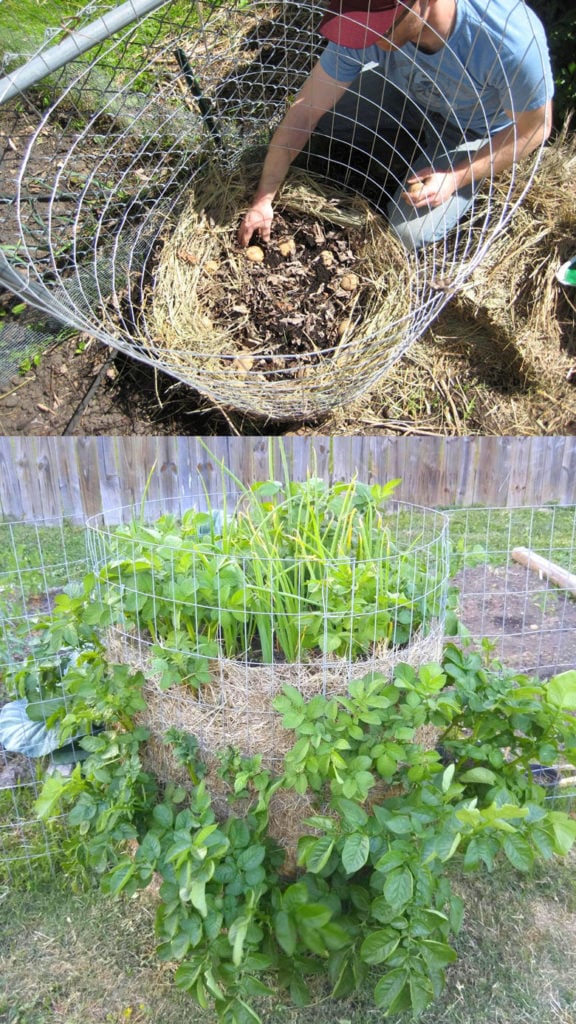
They are also hard to water and tend to dry out fast, even with fancy additions such as a perforated PVC pipe buried in the center. You would be lucky to get 3 or 4 potatoes from each seed potato.
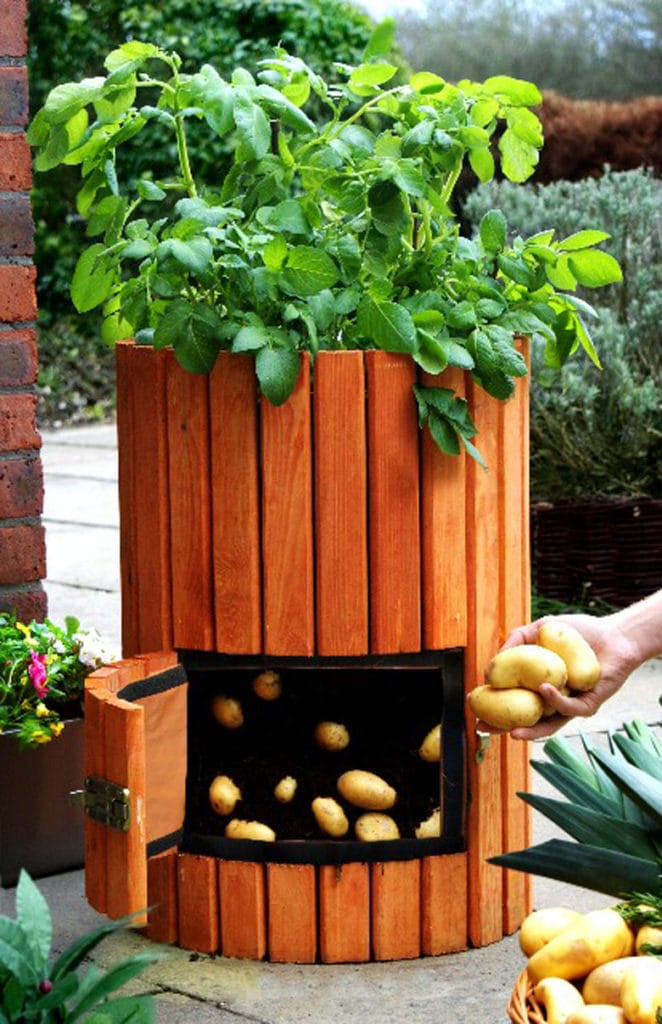
Planters like above can work if we do NOT use them like potato towers by burying the potato stems too much! Allow the massive healthy foliage to grow, which will result in a bigger harvest.
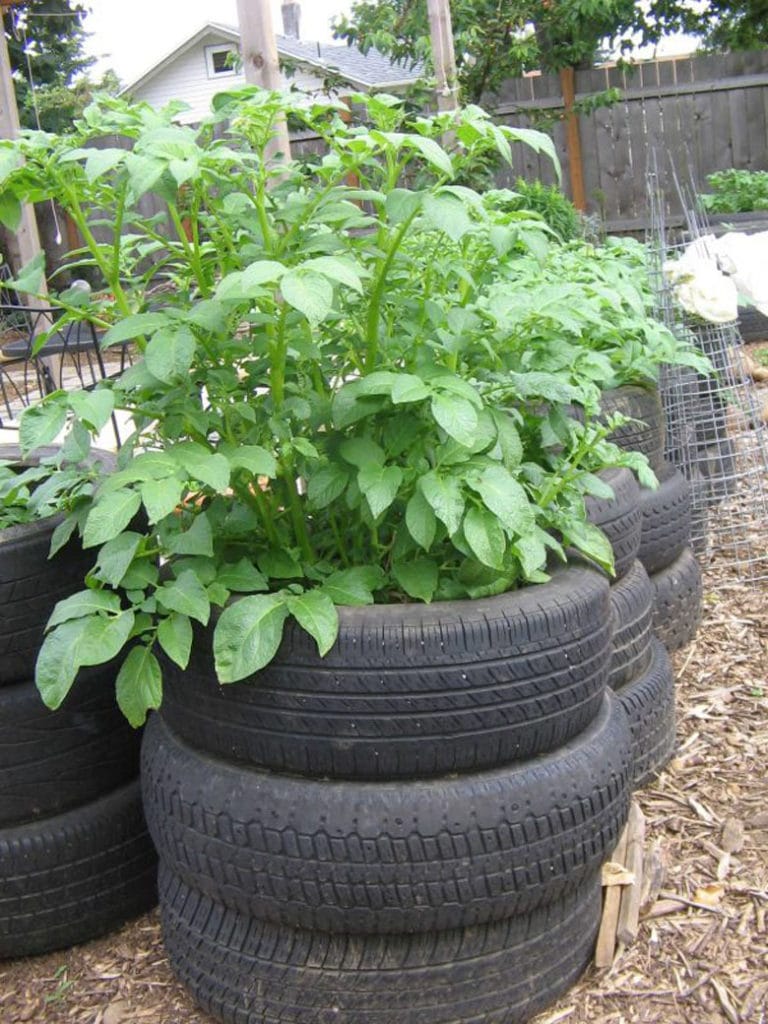
Another variation is to plant potatoes in stacked rubber tires. As much as I love Renee’s idea of up-cycled planters, many would argue rubber tires contain chemicals that may not be safe for food gardening! Below is a very good video explaining why.
Potato tower alternatives that work much better
First of all, all the potato towers we have seen above could be improve greatly by just treating them like a planter, and building them to no more than 18″ tall.
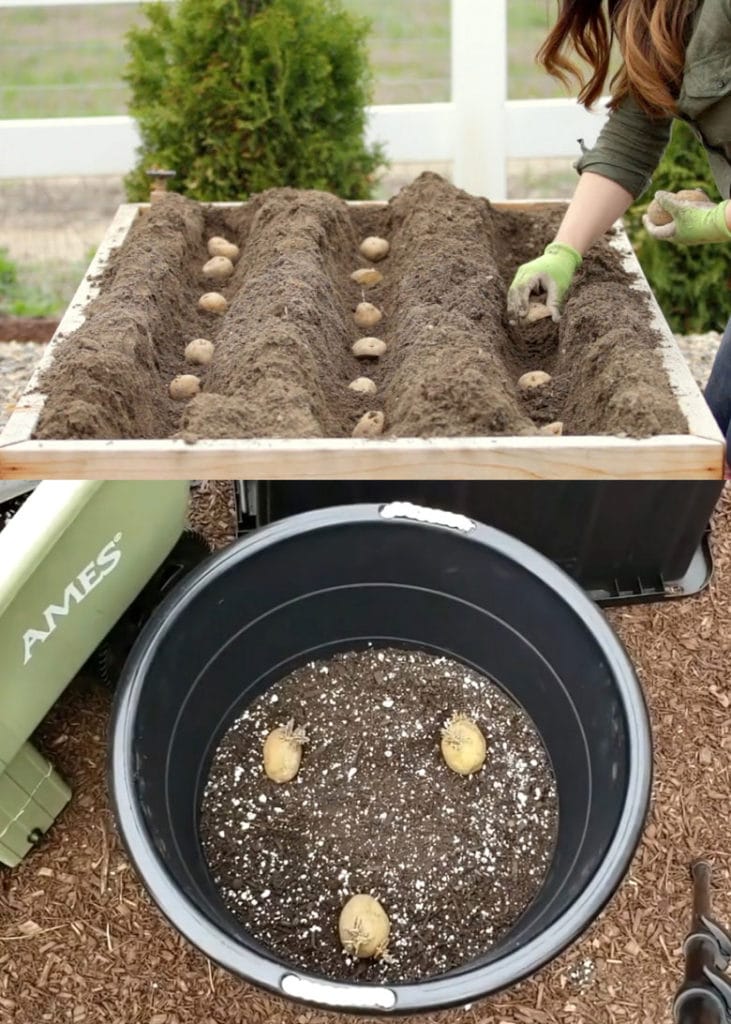
If you have a small space, you can grow potatoes in pots or small planter boxes. Here is a detailed guide on how to grow potatoes in containers, bags, pots, buckets and more!
There are many successful examples of growing potatoes in pots. 10 gallon pots or grow bags are the favorite among gardeners for planting potatoes. Tony on YouTube grew over 200 lbs of potatoes all in 10 gallon pots, check out his video below!
You can also make your own 10-gallon potato grow bags like in tutorial below.
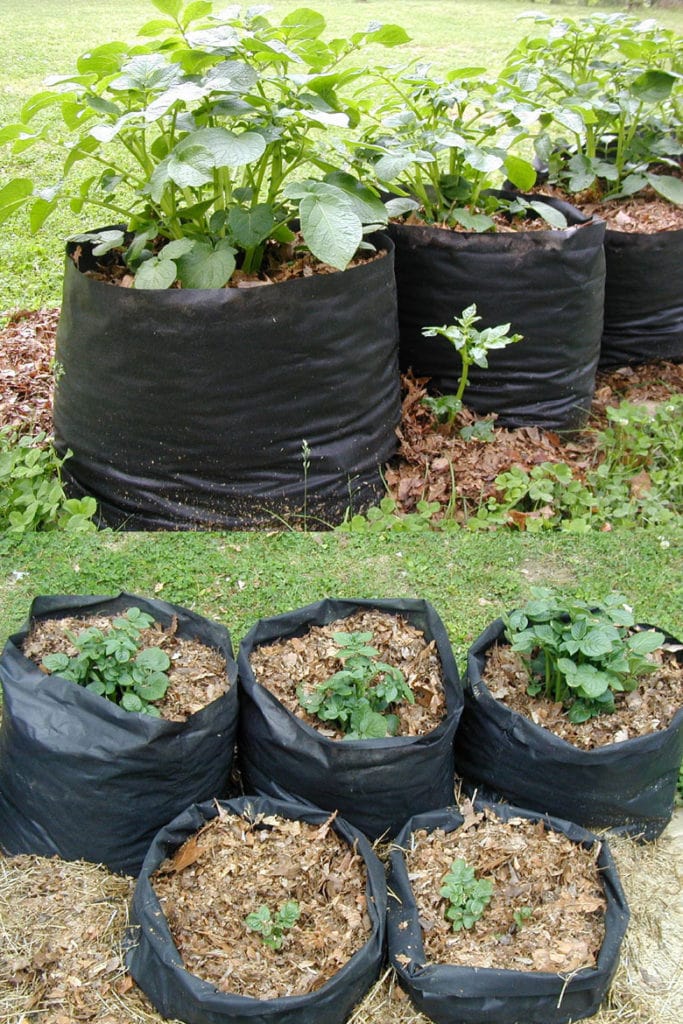
Another favorite method is to grow potatoes in a raised bed or in the ground.
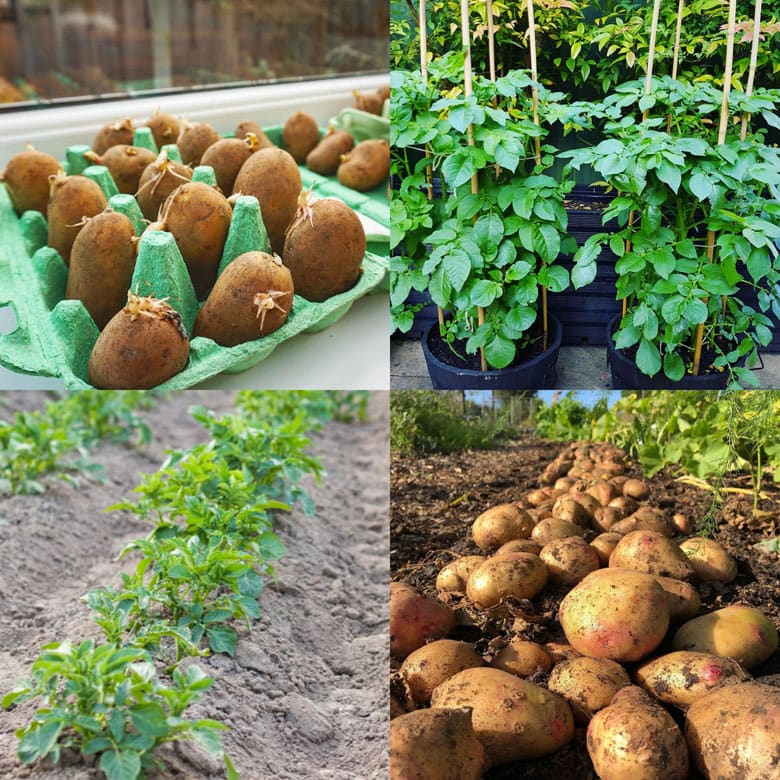
Check out these great guides on how to grow, harvest, and store potatoes, and 28 best DIY raised bed garden ideas!

Final conclusion: if you want to grow less potatoes with more work, then plant a potato tower and keep mounding the plants!
You CAN grow potatoes in DIY wire cage, straw mound, bag, or wood box with big yields, just don’t bury the stems for more than 6 inches! 🙂

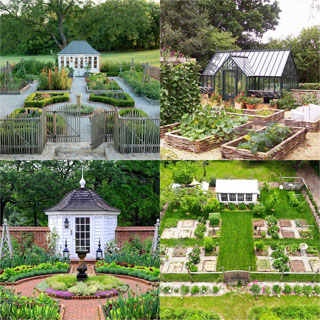

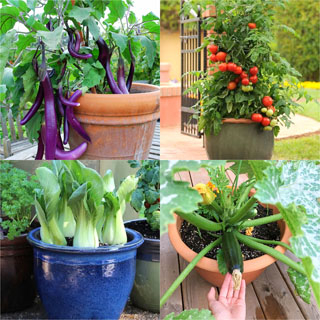
55 gallon food safe barrel sitting on top of 4 red bricks to allow any excess water to drain + 4 “eyes” from a Kennebec potato that sprouted under my kitchen sink = 50lbs of potatoes. Did this for 5 years until we moved. Everyone told us it would never work. Lost the bottom layer of potatoes (about 4 to 6) consistently. Placed a wire screen on the top of the barrel when the potato beetles were a problem. Removed the screen when the potatoes were flowering for pollination.
Did u start w just one layer of the potatoes and just keep adding soil?
The variety really makes a difference. I haven’t been able to do a tower, but I keep trying to find taller containers. Most of mine are grow bags. I try for 2′ tall. The Fingerling varieties are always poking thru the top of the soil with terrific production.
thank you allison! base on our experience, grow bags and 16″ to 18″ tall containers work better than those tall towers! 🙂
Tried the “Tower” a bunch of times, disappointing yields of small or tiny potatoes. Now I just have random taters all over the place. Better results for less effort
that was our experience too! pots or garden beds are easier and better! 🙂
This is SO helpful and answers many of the questions I’ve had about growing potatoes. Thank you!!!
My Grandpa grew his potatoes in straw towers and had great yields. I am trying a version of it with rabbit compost, dirt and straw. We’ll see what happens. I’ll try it out few ways before I say it doesn’t work. Mine have been staying moist so far and growing well.
hi Kayla! let us know how it goes! did your grandpa used to add soil around the stem as the plants grow? in our experience, that method does not improve yield at all. some people use the “towel” as a planter, and don’t bury the stems as the potatoes grow. this tend to work better IMO. 🙂
Our potato tower didn’t produce at all! This is exactly why!
Informative article! But I had great success from the mesh and straw method last year. From a 5lb. bag of potatoes (bought from the supermarket: I selected one with potoes which were already trying to sprout) I got a yeild of 40lbs! I chitted them first and cut them into pieces.
You are right though – don’t bury the plants but let them grow wild, water regularly and fertilize. It is something to do if you don’t have enough space to grow potatoes and/or your soil is not brilliant for them.
I followed this combination for the compost:-
The mixture is equal parts soil, compost, manure and peat.
You’ll also need:
Stiff wire mesh
Strong garden stake
Strong ‘zip ties’ to hold the sides of the tower together.
They say when putting the mixture together to make it moist; the video shows them using a hose on it while mixing and emphasises keeping it moist.
Then put in a layer of straw 4-6” thick, “create a nest by patting down the straw with a garden hoe and drawing some around the edges”. Add a layer of mixture 1”-2”, put potatoes around the edge (they had about 6) cover with mixture. Then add more mixture to make sure potatoes are fully covered on all sides.
Repeat process until full.
hi Missy! thank you so much for sharing your experience! 🙂 so the way you used it is more like a big planter made out of wire, which is actually the better way to plant potato “towers” among all the examples i have seen too! 🙂